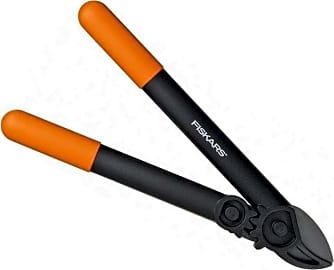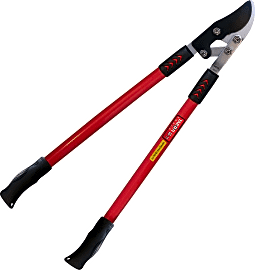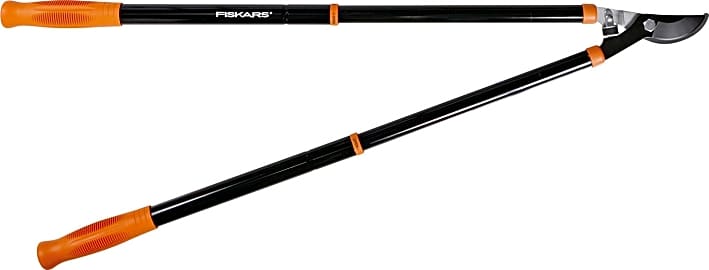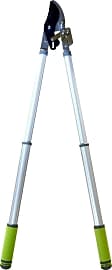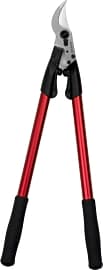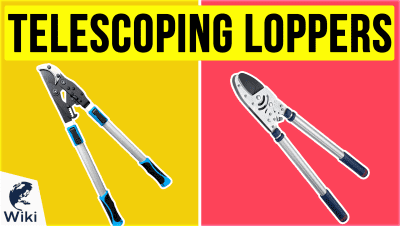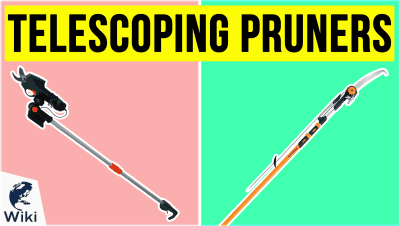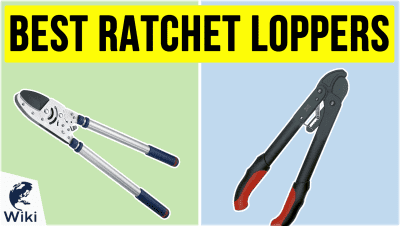The 10 Best Bypass Loppers

This wiki has been updated 37 times since it was first published in July of 2015. You can cut tough or high branches that need a little trimming easily and without a ladder using a pair of these durable and effective bypass loppers. We've included cutters for every kind of situation, including simple and affordable models for light pruning and more substantial options with compound and gear-driven joints that can slice through tree limbs up to two inches thick. When users buy our independently chosen editorial picks, we may earn commissions to help fund the Wiki.
Editor's Notes
March 24, 2021:
It was a pretty straightforward round of updates for us, with the vast majority of of our previous picks holding their own, but one issue that we did notice was that the Fiskars Quantum L108 weren't presently available. We weren’t able to confirm whether or not this option has been permanently discontinued, but decided to play it safe and remove it from out list, since we’re already including plenty of representation from the company, anyhow (namely the Fiskars 9166, Fiskars PowerGear2 and Fiskars PowerGear Super Pruners ).
In their place we added the Kings County Tools Green Wood, which caught our eye with its smart design, featuring conveniences like a 40-inch maximum handle length and six defined stops that make it easy to keep lengths even if you want to set them to something shorter (their minimum handle length is 26 inches). Kings County Tools is a trademark of the Garret Wade Company, which is based out of Brooklyn, New York, and has been in the tool game for a quarter century.
I mention this in case any of our users recognize these loppers as being virtually identical to an offering from Garret Wade, and are wondering which is the superior/knockoff option. If that is the case, I think you can safely assume that they’re virtually identical, as it looks very much like KCT is essentially a subdivision of GWC, one that’s mandate is strictly focusing on a portion of the company’s online sales. All this to say that, if you’re choosing between the two, pick whichever is the most affordable.
For further trimming solutions, you might be interested in our lists of telescoping pruners and pole saws.
February 26, 2020:
As opposed to anvil loppers, which bring a sharp blade to meet a solid piece of machined metal, bypass loppers bring the blade all the way past the lower portion of the head. If you're pruning a live tree as part of regular maintenance or doing anything else that relates to the health of the plant, you absolutely need a pair of bypass loppers, because while anvil loppers often provide a little better leverage, they're not good for the health of the plant because they tend to smash the remaining part that's still alive, which leads to poor healing and potential disease.
That said, there are a few different types of bypass loppers and they can all help in different applications. For small jobs, look to the Fiskars PowerGear Super Pruners, which are a mere 15 inches long but use wide gear blades to deliver the same amount of force as longer models with simpler joints. The Fiskars 9166 are particularly inexpensive, and feature extendable handles, but aren't the most comfortable and don't have the most cutting power. Sticking with this popular brand, the Fiskars Quantum L108 are a premium model with a number of advanced features as well as a pretty high price tag. The Fiskars PowerGear2, on the other hand, are reasonably priced and offer a gear drive as well as handle extensions, and are a great value for the money. It may stand out to you that we included four Fiskars models, but that's no accident; they make some of the most popular cutting devices from scissors to pole saws and pruners.
Of course, they aren't the only manufacturer around. The MLTools Easy Cut are a good choice if you're looking for a high-torque ratcheting model, although their advanced mechanics mean they can't be used at the same speed as simpler models. The Wolf-Garten Power Cut succeed in every area aside from blade durability. The Dramm ColorPoint are worth a look if you don't need telescoping handles, and the Corona SL 4364 DualLink and Tabor Tools GG11A are both mid-range extendable models that should serve homeowners well. If you're really looking for quality, the Felco 200 A cost a relative fortune, but are an extremely well-made piece of landscaping equipment. And if none of these are quite strong enough to get the job done, maybe check out a low-emissions electric chainsaw.
Special Honors
Grainger This outfit keeps a decent selection of loppers on hand, including a few of the bypass variety. Their website makes it easy to search according to blade material or handle material, which may make narrowing your choices easier. grainger.com
STIHLusa.com This company has a strong reputation for making quality tools, and their loppers are no exception, made with lightweight, aircraft-grade aluminum and backed by a limited lifetime warranty. If you don't see anything that looks like it can live up to your needs, you can always check out their selection of chainsaws. stihlusa.com
Bypass Loppers Versus Anvil Loppers
Bypass loppers work in a similar manner to scissors, except they make use of a single blade and a dull hook instead of two.
Loppers can be used on a range of branches from small 1/4" twigs up to thicker 1" limbs. They can cut through fresh green growth or old and dried wood. The key to effective lopper use, is picking the right kind of lopper for the job at hand.
Bypass loppers work in a similar manner to scissors, except they make use of a single blade and a dull hook instead of two. When they are closed, the single blade will move past the hook, creating a very clean cut. This passing action also prevents the blade from being dulled by the squared hook edge.
Anvil loppers are designed with a single sharp blade that closes against a flat surface. This flat surface is like an anvil on the opposite side of the jaws, and crushes anything between them.
Bypass loppers are best used on softer green material. Since it creates a cleaner cut than anvil loppers, it promotes quicker healing. If bypass loppers are used solely on green materials, they will rarely need sharpening as the blade doesn't come into contact with anything that will cause dulling. If bypass loppers are used on thick and dense dead wood, they will dull quickly.
They can also be damaged by exerting too much force when cutting. This can cause the blade to get pushed away from the flat jaw when closing and just pinch a branch sideways between the jaws without producing a cut. If this is done enough times, it can eventually result in the bypass loppers becoming unusable.
Anvil loppers are ideal for chopping off thicker, dead branches. They have a tendency to crush limbs as opposed to creating a clean cut, which is why they should not be used on live trees. This crushing effect takes longer to heal and leaves trees open to infection. Because the blade and anvil make contact every time a cut is made, they can dull quickly and will require constant sharpening.
Tips For Working With Loppers
Loppers are easy to use, but that doesn't mean there aren't a few tips that can make them more effective, last longer, and your life easier. One should always wear a pair of sturdy gloves when working with loppers. This will help prevent blisters in the palms and also make it easier to keep a firm hold on the handles. It is also vital that you don't allow the tool to twist while cutting. If this happens, more than likely they will not produce a cut, but will wind up just pinching the branch between the jaws.
As mentioned previously, the blade passes by the side of the dull jaw.
Ideally it is best to use loppers with the arms semi-extended or close to the body. If one tries to reach too far and fully extends the arms, it will require more force and cause the user to tire out quickly. It also reduces some of the users leverage.
Bypass loppers cut in line with the blade, not the dull jaw. For precision, line up the cut location with the sharp jaw before exerting force on the branch. As mentioned previously, the blade passes by the side of the dull jaw. If you line up the cut with the wrong jaw, the cut will be roughly 1/4' off of the location the user intends to cut.
It also helps to get the branch as deep into the jaws of the lopper as possible. They should not be used like scissors cutting paper a section at a time. If the branch cannot fit completely within the jaws, it is too big and should not be cut with loppers. Once the branch is properly positioned, close the loppers in one fluid motion to produce the cleanest cut.
Keeping A Healthy Garden
Keeping a healthy garden is the best way to ensure a beautiful one, with healthy, budding flowers and fruit. What some people don't realize is that bypass loppers are essential to plant health. Unlike anvil loppers, bypass loppers create a clean slice and help to avoid crushing the living tissue, which could lead to rot and disease.
This can be done by fully inspecting any new plants before bringing them home.
Of course, that might be considered most essential step in keeping a garden healthy: limiting the number of diseases and pests introduced externally. This can be done by fully inspecting any new plants before bringing them home. Check the tops and bottoms of the leaves and the branches for pests or signs of disease. The roots should also be closely examined for signs of root rot.
The plants in your garden should also regularly be inspected for pests and disease. If caught early enough, just removing or quarantining a single plant may be enough to stop them from spreading. Otherwise you may wind having to treat an entire garden which has been infected.
If using composted yard waste in new plantings, ensure that is had been fully composted. Partially composed waste can still harbor unwanted pathogens, which may cause diseases. When fertilizing a garden, make sure to use the proper fertilizer for the plant type, and in the correct ratio.
Using fertilizer that is too strong can burn the roots or leaves and even make it more difficult for a plant to absorb the nutrients it needs. If one uses the incorrect fertilizer, it may result in less blooms or an overabundance of an unwanted nutrient, which can stress a plant and make them more susceptible to disease.




